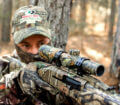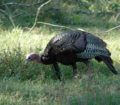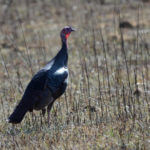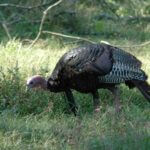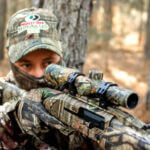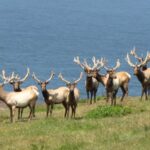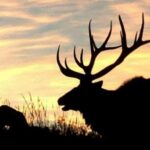John’s Note: As a youngster, J.R. Keller grew up in Delta, Colorado, and acquired a love for the outdoors from his father as he fished, hunted and camped with him. Through the years, Keller found a passion for turkey hunting that would consume most of his free time and lead him to become an avid turkey hunter and competition caller. This week we’re talking with J.R. about his turkey-hunting tactics.
 When I was hunting in Texas a few years ago, I thought I’d have a typical turkey hunt, strictly by the textbook, except that it was my first time to ever hunt in Texas. In Texas, the land was more open than where I usually hunted, and the turkeys roosted in mesquite flats and mesquite trees. The night before the hunt, I went out and roosted a turkey. I was convinced I had that turkey nailed to a tree. I’d studied the terrain, thought about how I could get close to the turkey the next morning before daylight and decided I’d have no trouble taking him.
When I was hunting in Texas a few years ago, I thought I’d have a typical turkey hunt, strictly by the textbook, except that it was my first time to ever hunt in Texas. In Texas, the land was more open than where I usually hunted, and the turkeys roosted in mesquite flats and mesquite trees. The night before the hunt, I went out and roosted a turkey. I was convinced I had that turkey nailed to a tree. I’d studied the terrain, thought about how I could get close to the turkey the next morning before daylight and decided I’d have no trouble taking him.
 I got up early the next morning and started sneaking toward the tree where my gobbler was roosted. I passed another roost tree and spooked a tom because I hadn’t seen where that turkey had flown up the previous evening. When that turkey flew out of his tree, he spooked the turkey in the tree that I was planning on hunting. I’d been so focused on reaching the turkey I’d roosted the night before that I wasn’t looking for any other turkeys in any of the trees near my gobbler’s roost tree. I finally took the turkey I’d intended to take in the morning late in the afternoon.
I got up early the next morning and started sneaking toward the tree where my gobbler was roosted. I passed another roost tree and spooked a tom because I hadn’t seen where that turkey had flown up the previous evening. When that turkey flew out of his tree, he spooked the turkey in the tree that I was planning on hunting. I’d been so focused on reaching the turkey I’d roosted the night before that I wasn’t looking for any other turkeys in any of the trees near my gobbler’s roost tree. I finally took the turkey I’d intended to take in the morning late in the afternoon.
From this Textbook Turkey, I’ve learned to:
* not leave the woods after I’ve seen one turkey fly-up when I’m roosting turkeys. I need to stay there until I’ve heard or seen all the other turkeys in the area fly-up.
* assume other turkeys always may be in the area where I’m hoping to hunt. Look, and listen for turkeys as you go to the gobbler you’ve roosted the previous night.
* never think a turkey hunt will be as simple or as easy as a turkey textbook says it will be.
With the Textbook Gobbler, I assumed that since I’d roosted the turkey, seen him fly up to the roost and selected the route I needed to travel to get to my calling site, all I’d have to do was to reach my calling site the next morning before daylight, take a stand there, make a few calls, let the gobbler fly off the roost to me, shoot the bird and get back to camp before the breakfast bacon had quit frying. That’s the way a textbook turkey hunt should be. But I relearned from this gobbler that very rarely would a turkey hunt happen the way the textbook on turkeys said a hunt should. I realized that when I hunted turkeys, I needed to expect the unexpected and change and adapt my turkey hunting to the terrain and the birds I encountered. Very rarely would I ever go right to a turkey that was gobbling from the roost, call him straight to me and return to camp in a short time.
 To learn more about turkey hunting, check out John E. Phillips’ print, Audible, Kindle and Nook turkey books at https://johninthewild.com/books/#turkey and at www.barnesandnoble.com. You also can download a free Kindle app that enables you to read the book on your iPad, computer or SmartPhone. You can learn more about calling turkeys by going to johninthewild.com/audio-files/ for audio turkey tapes to purchase of Lovett Williams, Rob Keck and Chris Kirby, available for download to your SmartPhone, tablet or computer. For a free copy of John E. Phillips’ “The Turkey Gobbler Getter Manual,” go to https://johninthewild.com/free-books/ to download.
To learn more about turkey hunting, check out John E. Phillips’ print, Audible, Kindle and Nook turkey books at https://johninthewild.com/books/#turkey and at www.barnesandnoble.com. You also can download a free Kindle app that enables you to read the book on your iPad, computer or SmartPhone. You can learn more about calling turkeys by going to johninthewild.com/audio-files/ for audio turkey tapes to purchase of Lovett Williams, Rob Keck and Chris Kirby, available for download to your SmartPhone, tablet or computer. For a free copy of John E. Phillips’ “The Turkey Gobbler Getter Manual,” go to https://johninthewild.com/free-books/ to download.

